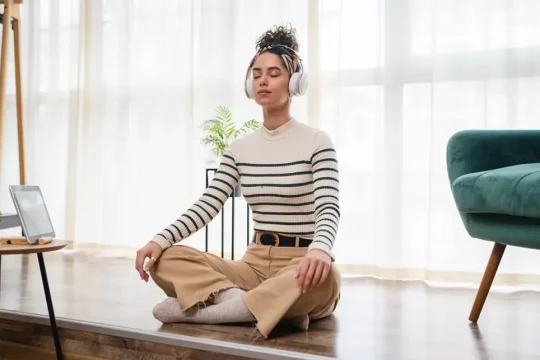Practicing mindfulness is one of the most effective ways to reduce anxiety and increase your enjoyment of life. Mindfulness empowers you to live in the moment and to accept yourself and others without judgment.
Mindfulness doesn’t require any special tools, books, or classes. Anyone who’s willing to practice can become a more mindful person. There are a wide variety of ways you can work toward mindfulness and decrease your anxiety.
What Is Mindfulness?
Mindfulness is the state of being fully conscious of the present moment. It involves being aware of your actions, thoughts, feelings, and external environment. Mindfulness encourages you to accept your current situation without self-judgment or criticism.
Everyone has the ability to be mindful. You probably have moments of mindfulness, but they can be few and far between. At any given moment, you may feel anxiety about either the past or the future. It takes time and effort to become more mindful, but there are a number of benefits. Mindfulness practice reduces the amount that your mind wanders to the past or the future, and it helps you achieve peace.
How Mindfulness Helps With Anxiety
There’s a strong connection between mindfulness and a decrease in anxiety. In many cases, anxiety is an instinctual, reactive feeling during a stressful or difficult situation. Mindfulness exercises can teach you to be aware of the situation without having a strong reaction.
Anxiety often results from worrying about the the future. For example, you may feel anxious about a a project coming up at work or something you want to say to a friend that you don’t want to come out wrong. While it’s impossible and unhealthy to move through life without any concerns, being constantly overwhelmed with anxiety over what’s about to happen is unhelpful. Mindfulness helps you move on through these moments.
Not knowing what’s going to happen in your life may lead to extreme worry or fear. You may review all the possibilities and options over and over in your mind until you can’t think of anything else. Planning for the future is important, but it also can become a major source of anxiety that keeps you from sleeping, eating, and taking care of yourself.
Mindfulness encourages you not to ruminate on the things you can’t control, and it also helps to reduce your anxiety about the future. When you focus your attention on the present moment, the volume of things you can worry about greatly decreases.
How to Practice Mindfulness Exercises
The only way for you to become more mindful, is to actively practice. Mindfulness also isn’t a skill that you can ever perfect. No one is entirely mindful all of the time, and no one goes through life without ever feeling anxiety. Instead, the goal of mindfulness is to gradually improve your mental and emotional health through consistent practice.
Here are five of the best mindfulness exercises that can help you reduce anxiety:
1. Meditation and Apps
Mindfulness is something you can work on as you go about your daily life, but setting aside time to focus solely on mindfulness is the best way to practice it. The more you practice mindfulness meditation, the easier it will become for you to be mindful in other situations.
In this day and age, everything you need to start your mindfulness practice is at your fingertips. There are dozens of mindfulness meditation apps, videos, and other online resources available. Many people find that guided meditation apps are a great way to get started, because they provide structure and support.
You don’t need to use a mindfulness app to meditate, though. To meditate on your own, find a quiet and comfortable place to sit. Focus your attention on your breath, noticing how it feels as you inhale and exhale. Then, think about the sounds or other sensations you notice in the present moment. Whenever your mind wanders, gently direct it back to your breathing or to your senses.
Your mindfulness meditation sessions can be very short as you get comfortable with the practice. Five to ten minutes of meditation per day can do wonders for your stress and anxiety. As it becomes easier, you can gradually increase the length of the sessions.
2. Time in Nature
Research shows that spending time in nature decreases stress and anxiety. For example, a 2015 study compared participants’ brain activity after walking in nature versus walking in a city. Those who spent time in nature showed less prefrontal cortex activity, which is the area of the brain that deals with negative and repetitive thoughts.
Nature is a great place to practice mindfulness because it’s a change of scene from your normal home environment. It also offers many different sensory experiences for you to focus on. As you walk in the woods, you can listen to the birds singing and the trees rustling, you can see the bright colors around you, and you can feel the sun or the breeze on your skin. Paying attention to these types of experiences is an easy, enjoyable way to be mindful.
3. Journaling
The physical act of writing helps you give conscious attention to your thoughts. There are limitless ways to journal, and you can write in whatever way makes you feel mindful and present.
One popular option is gratitude journaling, which involves logging everything you’re grateful for. You can write daily in your gratitude journal about the specific events of that day that make you feel thankful.
You don’t have to use a specific theme or format for your journal, though. Keeping a daily log of your thoughts, feelings, experiences, or anything else you want to write about can decrease your anxiety and help you find clarity.
4. Coloring
Coloring gives you something external to focus on, so it brings your attention away from yourself or your worries about the past and future. One study found that coloring mandalas can bring people into a meditative state. Within 20 minutes of coloring, the participants experienced a significant decrease in anxiety.
Drawing free-hand may be beneficial for some people as well, but coloring in a pre-printed design may be better for mindfulness. Staying in the lines requires focus, intention, and planning, so it can use up more of your brainpower.
5. Break From Technology
Technology is a source of constant distraction and stimulation, and it can easily become overwhelming. Social media in particular is a major source of anxiety for many people. If you constantly compare yourself to others on social media or regularly reach for your phone to scroll mindlessly, taking a break from technology is probably wise.
In moments where you would typically take out your phone, try to avoid using it. You don’t need to scroll through Instagram while eating dinner or browse Facebook while in line at the store. Instead, accept these idle moments and try to simply exist in them.
Mindfulness exercises aren’t easy, especially in our fast-paced, easily-distracted world. However, the benefits of mindfulness are worth the effort it takes to develop the skill. Mindful people experience less anxiety and more peace, and they tend to be happier and healthier than people who are stuck in the past or fixated on the future.
If you’re struggling with anxiety, stress, or other mental health concerns, consider speaking with a therapist. Therapy is an excellent opportunity to start your mindfulness practice, learn coping skills, and work through life’s challenges with support from a professional. Contact The Beverly Hills Therapy Group to learn more.




